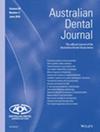下载PDF
{"title":"Intracoronal tooth bleaching – A review and treatment guidelines","authors":"M Amer","doi":"10.1111/adj.13000","DOIUrl":null,"url":null,"abstract":"<p>Intracoronal bleaching is a minimally invasive procedure that was introduced into dentistry in the 19th century. The role of that procedure in enhancing the colour of teeth subjected to internal discolouration while being conservative made it extremely popular amongst dental professionals. Different materials and techniques have been utilized over the years attempting to obtain predictable long-term results while minimizing any associated risks. Contemporarily, bleaching agents are mainly based on peroxide-releasing compounds in different formulations and delivery systems. Different theories have been formulated on the bleaching mechanism of such agents, but the exact mechanism is yet to be proven. The effect of hydrogen peroxide-based bleaching agents on the organic structure of enamel and dentine has been extensively investigated to address the effects of bonding of resin-based restorative materials to hard tooth structure. Multiple case reports raised a concern about the contribution of intracoronal bleaching in developing invasive root resorption. Modification of intracoronal bleaching techniques was thus necessary to address such concerns. This review will provide a summary of the important aspects of intracoronal bleaching, focusing on how it applies to the contemporary clinical setting. © 2023 Australian Dental Association.</p>","PeriodicalId":8593,"journal":{"name":"Australian dental journal","volume":"68 S1","pages":"S141-S152"},"PeriodicalIF":2.4000,"publicationDate":"2023-11-17","publicationTypes":"Journal Article","fieldsOfStudy":null,"isOpenAccess":false,"openAccessPdf":"https://onlinelibrary.wiley.com/doi/epdf/10.1111/adj.13000","citationCount":"0","resultStr":null,"platform":"Semanticscholar","paperid":null,"PeriodicalName":"Australian dental journal","FirstCategoryId":"3","ListUrlMain":"https://onlinelibrary.wiley.com/doi/10.1111/adj.13000","RegionNum":4,"RegionCategory":"医学","ArticlePicture":[],"TitleCN":null,"AbstractTextCN":null,"PMCID":null,"EPubDate":"","PubModel":"","JCR":"Q2","JCRName":"DENTISTRY, ORAL SURGERY & MEDICINE","Score":null,"Total":0}
引用次数: 0
引用
批量引用
Abstract
Intracoronal bleaching is a minimally invasive procedure that was introduced into dentistry in the 19th century. The role of that procedure in enhancing the colour of teeth subjected to internal discolouration while being conservative made it extremely popular amongst dental professionals. Different materials and techniques have been utilized over the years attempting to obtain predictable long-term results while minimizing any associated risks. Contemporarily, bleaching agents are mainly based on peroxide-releasing compounds in different formulations and delivery systems. Different theories have been formulated on the bleaching mechanism of such agents, but the exact mechanism is yet to be proven. The effect of hydrogen peroxide-based bleaching agents on the organic structure of enamel and dentine has been extensively investigated to address the effects of bonding of resin-based restorative materials to hard tooth structure. Multiple case reports raised a concern about the contribution of intracoronal bleaching in developing invasive root resorption. Modification of intracoronal bleaching techniques was thus necessary to address such concerns. This review will provide a summary of the important aspects of intracoronal bleaching, focusing on how it applies to the contemporary clinical setting. © 2023 Australian Dental Association.
牙冠内漂白-回顾和治疗指南。
冠状内漂白是一种微创手术,于19世纪引入牙科。该程序在增强牙齿颜色方面的作用,使牙齿内部变色,同时保持保守,这在牙科专业人员中非常受欢迎。多年来,不同的材料和技术一直在尝试获得可预测的长期结果,同时将任何相关风险降至最低。目前,漂白剂主要基于不同配方和输送系统的过氧化物释放化合物。关于这类漂白剂的漂白机理已有不同的理论,但确切的机理尚未得到证实。过氧化氢漂白剂对牙本质和牙釉质有机结构的影响已被广泛研究,以解决树脂基修复材料与硬牙结构结合的影响。多个病例报告提出了对冠内漂白在发展侵入性牙根吸收中的作用的关注。因此,有必要改进冠状内漂白技术来解决这些问题。这篇综述将提供一个总结的重要方面的冠状内漂白,重点是如何适用于当代临床设置。©2023澳大利亚牙科协会。
本文章由计算机程序翻译,如有差异,请以英文原文为准。

 求助内容:
求助内容: 应助结果提醒方式:
应助结果提醒方式:


